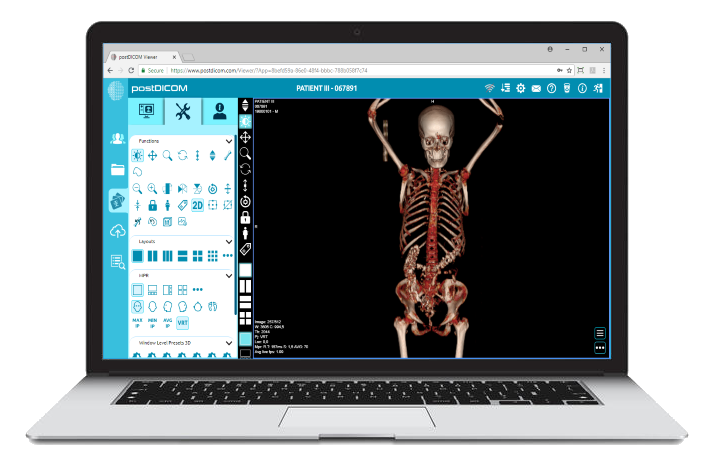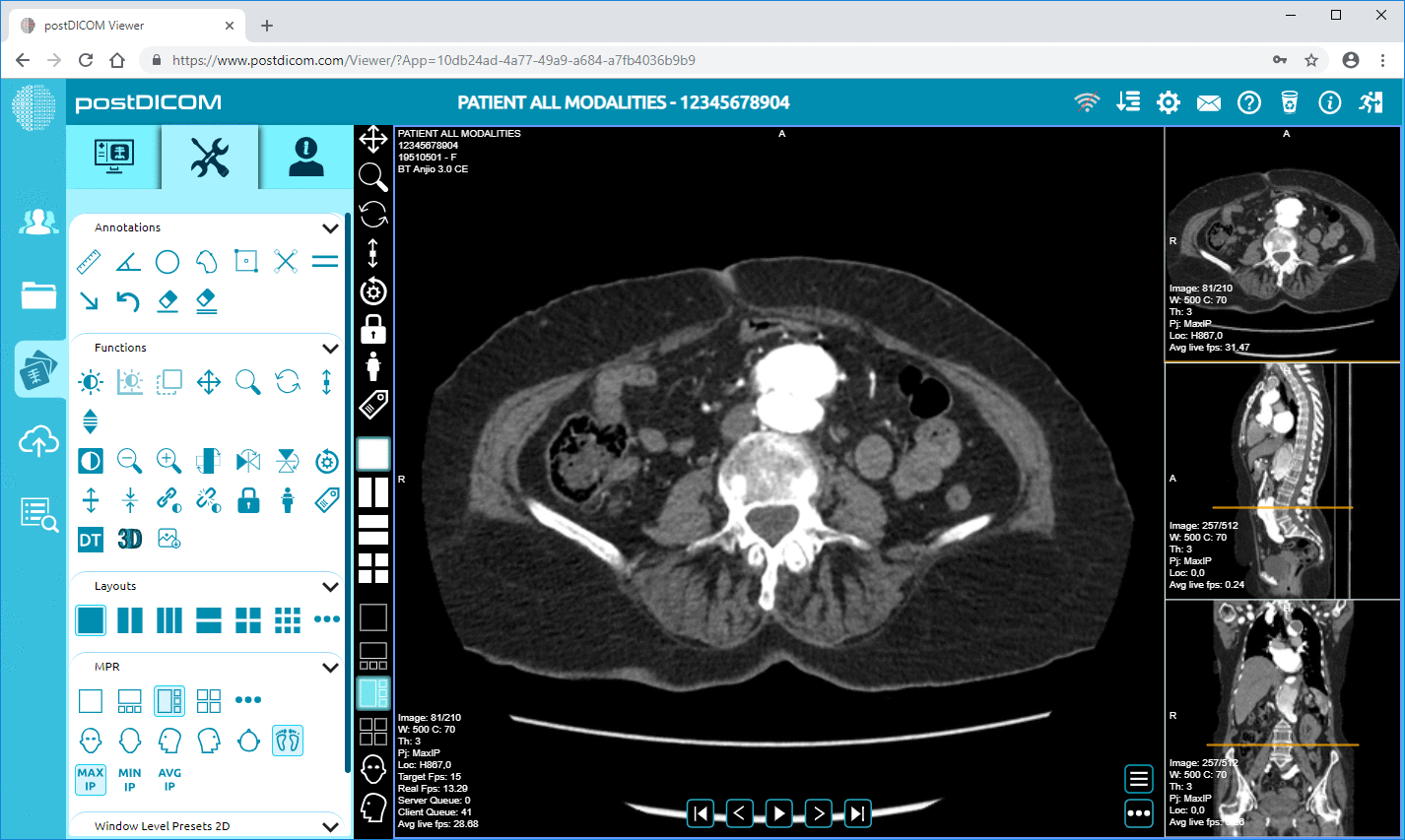
Veterinary teleradiology is a subfield of veterinary telemedicine that involves using a tool to exchange medical information electronically, specifically radiographic images (X-rays, CT scans, MRIs, etc.) and related patient information, from one location to another to improve a patient's clinical health status.
This technology allows veterinarians to collaborate with specialists remotely, improving diagnostic accuracy and patient care, especially when access to specialists is limited.
Veterinary teleradiology serves several important purposes:
• Enhanced Diagnostic Accuracy: Teleradiology improves diagnostic accuracy by enabling general practitioners to consult with board-certified radiologists, leading to more effective treatment plans. For general practitioners, sending radiographs for consultation provides the benefit of a staff radiologist without the expense and improves diagnostic accuracy.
• Improved Patient Outcomes: Faster and more accurate diagnoses through teleradiology can lead to quicker interventions and better outcomes for animal patients.
• Increased Efficiency: Teleradiology streamlines obtaining expert opinions, reducing turnaround time and improving workflow efficiency for veterinary teams.
• Access To Specialists: Teleradiology provides veterinarians in remote areas or those without in-house radiology capabilities with access to specialized expertise.
A typical veterinary teleradiology system involves the following components:
• Image Acquisition: Digital radiographic images are acquired using X-ray, CT, MRI, or other imaging modalities.
• Image Digitization: If images are not already in a digital format, they are digitized using scanners or other devices.
• Image Transmission: Digital images are transmitted securely over a broadband internet connection to a remote server.
• Teleradiology Platform: A secure online platform is used for image storage, viewing, and interpretation. Images to the platform are submitted online through a web-based program that interfaces with your local X-ray practice's machine's image database. DICOM images on the local X-ray system are selected and uploaded to the server, along with the case history and other pertinent clinical information (blood work, etc.). Once submitted, the radiologist will automatically receive notification by email that a case is pending; the referring practice will also receive confirmation that the submission is complete.
• Radiologist Review: A board-certified veterinary radiologist reviews the images and provides a detailed report. As part of a consult, a teleradiologist will consider the patient's history, clinical condition, and radiographic findings to provide a list of differential diagnoses and recommendations.
• Report Delivery: The radiologist's report is delivered electronically to the referring veterinarian.
 - Presented by PostDICOM.jpg)
Veterinary teleradiology can be used with various medical imaging modalities, including:
• X-rays: The most common application of teleradiology in veterinary medicine, used for diagnosing various conditions, including fractures, dislocations, and internal organ abnormalities.
• Ct Scans: Provide detailed cross-sectional images of the body, helpful in evaluating complex cases such as tumors, spinal cord injuries, and internal bleeding.
• Mri Scans: Use magnetic fields and radio waves to create detailed images of organs and tissues, which are particularly helpful for diagnosing neurological conditions and soft tissue injuries.
• Ultrasound Usessound Waves To Create Real-time Images Of Internal Organs. It Is A Separate Modality From Ct Or Mri And Is Often Used To Evaluate Pregnancy, Abdominal Masses, And Cardiac Function.
• Reduced Turnaround Time For Interpretations.
• Improved Access To Specialists.
• Enhanced Diagnostic Accuracy.
• Increased Efficiency And Workflow.
• Cost-effectiveness.
• Convenience For Both Veterinarians And Clients.
• Improved Patient Outcomes.
• Continuing Education Opportunities For Veterinarians.
• This Is Crucial In Emergencies When Immediate Veterinary Advice Can Be Life-saving.
• Establishing A Valid Veterinarian-client-patient Relationship (vcpr).
• Ensuring Adequate Internet Connectivity In Remote Areas.
• Addressing Concerns About The Quality Of Care Provided Remotely.
• Maintaining Data Security And Confidentiality.
• Potential Technical Issues With Image Transmission And Viewing.
• The A Need For Clear Communication And Collaboration Between Veterinarians And Radiologists.
While teleradiology offers many benefits, such as convenience, cost-effectiveness, and improved access to specialists, challenges remain in establishing a valid VCPR, maintaining the quality of care in a remote setting, and addressing potential technical issues.
The ACVR emphasizes the importance of image quality and standardization in teleradiology by recommending a minimum spatial resolution standard for digital radiographic devices and advocating for DICOM compliance for teleradiology systems.
Veterinary teleradiology is a valuable tool that can enhance the quality of care provided to animal patients.
By improving access to specialists, increasing efficiency, and reducing costs, teleradiology offers significant benefits for veterinarians and clients. However, it is essential to address the challenges associated with this technology, such as ensuring proper VCPR, maintaining data security, and addressing concerns about the quality of remote care.
As technology evolves and regulations adapt, veterinary teleradiology will likely become increasingly important in the future of veterinary medicine.
The increasing adoption of telemedicine in veterinary practice highlights the growing need for ongoing development of standards and regulations to ensure quality of care and address ethical considerations. Veterinary teleradiology has the potential to significantly impact the veterinary profession by improving access to specialized expertise, particularly in underserved or remote areas.
This can lead to more accurate diagnoses, timely interventions, and ultimately, better outcomes for animal patients. However, it is crucial to balance the advantages of technology and the importance of the traditional veterinarian-client-patient relationship, ensuring that animal welfare remains the top priority.


|
Cloud PACS and Online DICOM ViewerUpload DICOM images and clinical documents to PostDICOM servers. Store, view, collaborate, and share your medical imaging files. |